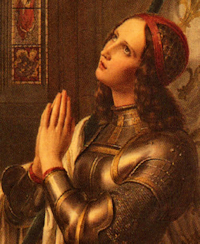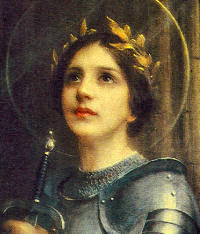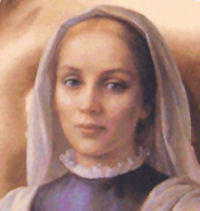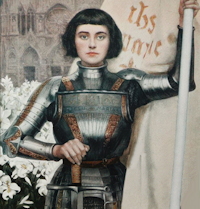Ordinary Time: May 30th
Saturday of the Eighth Week of Ordinary Time
Other Commemorations: St. Joan of Arc, Virgin & Martyr (RM); St. Dymphna, Virgin & Martyr (RM); Hubert of Liege, Bishop (RM)
» Enjoy our Liturgical Seasons series of e-books!
According to the 1962 Missal of St. John XXIII the Extraordinary Form of the Roman Rite, today is the feast of Corpus Christi which traditionally is celebrated on the Thursday after Trinity Sunday. In the Ordinary Rite the Solemnity is celebrated on the Sunday after Trinity Sunday.
Also today is the feast of Pope St. Felix I, who governed the Church from 268 to 273. St. Felix I was buried in the "crypt of the popes," in the catacomb of St. Callixtus, and is often confused with the second century martyr St. Felix, a victim of persecution under the Emperor Marcus Aurelius.
Also it is the feast of St. Joan of Arc (some places), Patron saint of France. In her day, the English were allied with the Burgundians in a war against the rest of France. Joan was compelled by voices of her favorite saints to take up arms in defence of her country. Dressed in a suit of white armor, she led the French in battle against the English, who retreated, believing that she was in league with the devil. She continued to battle against the English, with dwindling support, until she was eventually captured and tried as a witch. She was found guilty and at the scaffold she pleaded guilty in exchange for a pardon from the Church. However, since the English had no intention of releasing her from prison, she quickly renounced her confession and resumed wearing men's clothing. For this they publicly burned her at the stake for witchcraft and heresy. The Church reversed its decision in 1455, and she was canonized in 1920.
St. Joan of Arc
 Saint Joan was born on January 6, 1412, in the village of Domremy to Jacques and Isabelle d'Arc. Joan was the youngest of their five children. While growing up among the fields and pastures of her village, she was called Jeannette but when she entered into her mission, her name was changed to Jeanne, la Pucelle, or Joan, the Maid.
Saint Joan was born on January 6, 1412, in the village of Domremy to Jacques and Isabelle d'Arc. Joan was the youngest of their five children. While growing up among the fields and pastures of her village, she was called Jeannette but when she entered into her mission, her name was changed to Jeanne, la Pucelle, or Joan, the Maid.
As a child she was taught domestic skills as well as her religion by her mother. Joan would later say, "As for spinning and sewing, I fear no woman in Rouen." And again, "It was my mother alone who taught me the 'Our Father' and 'Hail Mary' and the 'Creed;' and from none other was I taught my faith."
From her earliest of years Joan was known for her obedience to her parents, religious fervor, goodness, unselfish generosity and kindness toward her neighbors. Simonin Munier, one of Joan's childhood friends, tells how Joan had nursed him back to health when he was sick. Some of her playmates teased her for being 'too pious.' Others remembered how she would give up her bed to the homeless stranger who came to her father's door asking for shelter.
Joan was 'like all the others' in her village until her thirteenth year. "When I was about thirteen, I received revelation from Our Lord by a voice which told me to be good and attend church often and that God would help me." She stated that her 'Voices' were Saint Michael the Archangel, Saint Catherine and Saint Margaret. At first her 'Voices' came to her two or three times a week but as the time for her mission drew near (five years later), they visited her daily telling her to 'Go into France' to raise the siege of Orleans, conduct the Dauphin Charles to Reims for his crowning and to drive the English from the land.
Joan went to the neighboring town of Vaucouleurs, which means Valley of many colors. There she spoke to the loyal French governor by the name of Sir Robert de Baudricourt. After many rejections he finally agreed to send her to the Dauphin who at the time was living at the castle of Chinon.
On the evening of February 23, 1429, she began her mission for God. In the company of six men, she rode through the Gate of France on her way to Chinon. Joan reached this town on March 6th, but was not received by the Dauphin, Charles, until the evening of March 9th.
After being accepted and approved by a Church council headed by the Archbishop of Reims, Joan was allowed to lead the Dauphin's army. This part of her career was meteoric. She entered Orleans on the evening of April 29th and by May 8th the city had been freed. The Loire campaign started on June 9th and by June 19th the English were driven out of the Loire valley. The march to Reims started on June 29th and by July 17th Charles was crowned King of France in the cathedral of Reims.
 From this time on, for reasons know only to King Charles, the king no longer valued Joan's advice and guidance. She had always told him that God had given her 'a year and a little longer' to accomplish His will but the king seemed to take no notice of it. For almost a year he wasted what time remained to Joan, until in frustration, she left the court. Her last campaign lasted from the middle of March until her capture at the town of Compiegne on May 23rd, 1430. Her 'year and a little longer' was over.
From this time on, for reasons know only to King Charles, the king no longer valued Joan's advice and guidance. She had always told him that God had given her 'a year and a little longer' to accomplish His will but the king seemed to take no notice of it. For almost a year he wasted what time remained to Joan, until in frustration, she left the court. Her last campaign lasted from the middle of March until her capture at the town of Compiegne on May 23rd, 1430. Her 'year and a little longer' was over.
Abandoned by her king and friends, she started her year of captivity. As a prisoner of the Burgundians she was treated fairly but that all changed when on November 21st, 1430, she was handed over the English. How she survived their harsh treatment of her is a miracle in itself.
The English not only wanted to kill Joan but they also wanted to discredit King Charles as a false king by having Joan condemned by the Church as a witch and a heretic. To obtain this goal the English used those Church authorities whom they knew to be favorable to them and the staunchest of these was Bishop Cauchon.
Joan's trial of condemnation lasted from February 21st until May 23rd. She was finally burnt at the stake in Rouen's market square on May 30th, 1431.
Twenty-five years later the findings of Joan's first trial were overturned and declared 'null and void' by another Church court, who this time was favorable to King Charles. It was not until 1920 that the Church of Rome officially declared Joan to be a saint. Her feast day is celebrated on May 30th.
—Excerpted from St. Joan of Arc Center
Patronage: captives; imprisoned people; martyrs; opposition of Church authorities; people ridiculed for their piety; prisoners; rape victims; soldiers; WACs; WAVES; Women Appointed for Voluntary Emergency Service; Women’s Army Corps; France
Symbols and Representation: Bareheaded girl in armor with sword, lance or banner
Highlights and Things to Do:
- Read more about St. Joan:
- Visit the St. Joan of Arc Center.
- See the Joan of Arc Archive which contains translations of primary sources of her life.
- For a pictoral biography of St. Joan go Anastpaul and Christian Iconography.
- See Catholic Cuisine for some food ideas to celebrate St. Joan.
St. Dymphna
 Daughter of a pagan Irish chieftain named Damon, and a beautiful devoted Christian woman whose name has not come down to us. Her mother died when Dymphna was a teenager. Her father searched the Western world for a woman to replace his wife, but none could. Returning home, he saw that his daughter was as beautiful as her mother, and maddened by grief, he made advances on her. She fought him off, then fled to Belgium with Saint Gerebernus, an elderly priest and family friend.
Daughter of a pagan Irish chieftain named Damon, and a beautiful devoted Christian woman whose name has not come down to us. Her mother died when Dymphna was a teenager. Her father searched the Western world for a woman to replace his wife, but none could. Returning home, he saw that his daughter was as beautiful as her mother, and maddened by grief, he made advances on her. She fought him off, then fled to Belgium with Saint Gerebernus, an elderly priest and family friend.
Dymphna’s father searched for them, and his search led to Belgium. There an innkeeper refused to accept his money, knowing it was difficult to exchange. This told Damon that his daughter was close - it would be unusual for a village innkeeper to know a lot about foreign currency, and his knowledge indicated that had recently seen it. The king concentrated his search in the area. When he found them in Gheel, he beheaded Gerebernus, and demanded that Dymphna surrender to him. She refused, and he killed her in a rage.
The site where she died is known for its miraculous healings of the insane and possessed. There is now a well-known institution on the site, and her relics are reported to cure insanity and epilepsy.
—CatholicSaints.info
Patronage: Against sleepwalking; against epilepsy; against insanity; against mental disorders; against mental illness; epileptics; family happiness; incest victims; loss of parents; martyrs; mental asylums; mental health caregivers; mental health professionals; mental hospitals; mentally ill people; nervous disorders; neurological disorders; possessed people; princesses; psychiatrists; rape victims; runaways; sleepwalkers; therapists
Symbols and Representation: Being beheaded by the king; kneeling at Mass while her father murders the priest Gerebernus; lamp; praying in a cloud surrounded by a group of lunatics bound with golden chains; princess holding a lamp and sword; princess with a sword holding the devil on a leash; young woman with Saint Gerebernus
Highlights and Things to Do:
- Vist the National Shrine of St. Dymphna.
- Pray the Chaplet of St. Dymphna.
- Read more about St. Dymphna:
- See the National Shrine of St. Dymphna in Massillon, Ohio.
- The National Gallery of Ireland has a beautiful image of "St Dymphna. The Tragedy of an Irish Princess."
St. Hubert of Liege
 Late in the eighth century, so runs the story, a hunter named Hubert, neither better nor worse than he should have been, was tracking a stag through the forest of the Ardennes. As he readied himself to shoot the animal with his arrow, he was startled when the stag turned suddenly in its flight, and he saw between its antlers a luminous cross. This experience caused Hubert to change his way of life, and he never hunted again. Yet only a few centuries later he was known as the patron of hunters, and is a saint greatly honored in France and Belgium.
Late in the eighth century, so runs the story, a hunter named Hubert, neither better nor worse than he should have been, was tracking a stag through the forest of the Ardennes. As he readied himself to shoot the animal with his arrow, he was startled when the stag turned suddenly in its flight, and he saw between its antlers a luminous cross. This experience caused Hubert to change his way of life, and he never hunted again. Yet only a few centuries later he was known as the patron of hunters, and is a saint greatly honored in France and Belgium.
Saint Hubert lived a full life. He became bishop of Tongres and traveled through his huge diocese on horseback and by boat, preaching and building churches to the glory of God. He was the friend of the great of his day—Pepin of Heristal and Charles Martel among them—and also of the poor. In particular his heart went out to prisoners, and he would secretly place food for them before their dungeon windows. As he died he said to those about him, "Stretch the pallium over my mouth for I am now going to give back to God the soul I received from Him."
In parts of France and Belgium there has long been a custom of holding stag hunts on Saint Hubert's Day, and the hunters gather before the chase for Mass and the blessing of men and horses and dogs. After the hunt is over, those taking part gather for a bountiful breakfast consisting of fish, meat, salad, cheese, and dessert. Naturally the meat is venison of some sort, and the salad may well be one of dandelion greens.
—Excerpted from Feast Day Cookbook by Katherine Burton and Helmut Ripperger, 1955.
Patronage: Archers; dog bite; dogs; forest workers; furriers; hunters; hunting; huntsmen; hydrophobia; liege, Belgium; machinists; mad dogs; mathematicians; metal workers; precision instrument makers; rabies; smelters; trappers.
Symbols and Representation: Bishop celebrating Mass as an angel brings him a scroll; bishop with a hound and hunting horn; bishop with a stag with a crucifix; huntsman adoring a stag with a crucifix in its antlers; kneeling before a stag as an angel brings him a stole; kneeling in prayer, a hound before him and often with hunting gear nearby; knight with a banner showing the stag's head and crucifix; stag; stag with a crucifix over its head; young courtier with two hounds.
Highlights and Things to Do:
- Have roast venison in honor of St. Hubert, patron of hunters. See the recipe section.
- Read more about St. Hubert:
- Have a toast of Jägermeister in honor of St. Hubert.
- Although not an original saint of the Fourteen Holy Helpers, St. Hubert is included in a subset of the original Helpers, the Four Holy Marshals: Quirinus, Hubert, Cornelius and Anthony the Great, Quirinus of Neuss, Hubert of Liege, Cornelius, and Anthony the Great.
- St. Hubert's feast was originally November 3, but the 2004 Roman Martyrology transferred it to May 30, which was the anniversary of the translation of his relics.








